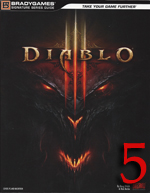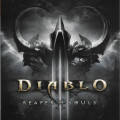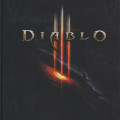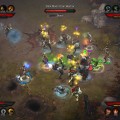 When setting out to review a game with the depth and breadth of a Diablo III, the authors have to be approaching the task with a hole in the pit of their stomach the size of the Grand Canyon. Not only is this the highly anticipated sequel to one of the most successful–and still widely played–PC games of all time, but it also contains a level of complexity that is unparalleled amongst its peers. Oh, and let’s not so quickly forget that the game has been in development hell (no pun intended) for over a decade. Suffice to say that BradyGames had their work cut out for themselves with their Diablo III strategy guide.
When setting out to review a game with the depth and breadth of a Diablo III, the authors have to be approaching the task with a hole in the pit of their stomach the size of the Grand Canyon. Not only is this the highly anticipated sequel to one of the most successful–and still widely played–PC games of all time, but it also contains a level of complexity that is unparalleled amongst its peers. Oh, and let’s not so quickly forget that the game has been in development hell (no pun intended) for over a decade. Suffice to say that BradyGames had their work cut out for themselves with their Diablo III strategy guide.
By virtue of Diablo III randomly generating everything from level layouts to enemy positions to loot drops, it is amazing that the guide is as comprehensive as it is. Their key seemed to be setting aside the unknowns and focusing on what will always remain the same, namely, the different character (hero) classes, the numerous enemy types, and the seemingly never ending well that is Blizzard’s loot chest. From there, the authors continued to drill down until they hit pay dirt in a big way.
The book starts out by breaking down all of the game’s core mechanics in a level of detail that would leave even a Diablo virgin (God help your poor soul) feeling like a Rhodes Scholar. Among the key elements detailed are leveling, choosing what loot to gather vs. discard, managing and picking effective party members, and online coop play. There is even a specific section dedicated to ancillary party members, their specific perks, and what skills they will learn as players level. And here is the scary part: this section only represents roughly about 3% of the overall text.
Next up is the absurdly deep analysis of each of the five hero classes. Each hero is split up into sections discussing the character’s specific weaponry, armor, and skills. Further exemplifying the insanity of depth in the guide, every skill, both actively employed by the player and unconsciously applied to modify status effects, are given the utmost attention. Details passed along are things like levels unlocked, tactics that can be applied to its use, runes that will have an additional effect when equipped, and the five additional permutations to the skill that can be unlocked and applied throughout the leveling process. Everything is present to help players make the best possible decision with their characters, plus a little bit of added clairvoyance as to what can be expected as the game progresses.
What follows this up is the actual walkthrough of every one of the campaign’s thirty-one quests. Each mission is broken up into its individual objectives, with vague details about what can be expected intermixed throughout the text. It seems as if these sections are specifically worded to avoid being a specific “point A to point B” walkthrough. As a reminder, the maps, enemy positioning, and loot containers are randomly generated, so the only specifics that are passed along are new enemies that may be encountered, the steps in between objectives, and basic strategies for accomplishing each quest’s few scripted encounters. Be sure not to forget to pay special attention to the bonus objectives that are spelled out, because the additional loot drops and experience net could pay off down the road.
One thing that the guide does exceptionally well is calling out boss encounters and providing players with the best approaches to slaying the usually overpowered adversary. The enemy’s expected hit-point count, XP level, and attacks are spelled out explicitly, along with their special traits and resistances. This is one of the rare areas where specific strategy and tactics are provided to the player, which can in turn prove to be tremendously helpful.
After digging through four acts worth of campaign direction, players are most likely curious about how they can apply their specific skills and items acquired throughout. For this reason, it only makes sense that the next area breaks down the different artisans and crafting options at the player’s disposal. Though you can go through the entirety of the game using only dropped loot, sometimes it is good to know what other options are available and when these elements can be upgraded.
Did you know that all of those goofy generated item names like “Chilling Bow of Infinity,” actually mean something extremely specific under the hood? Despite sounding like complete gibberish to most, the next section breaks down every item, as well as its specific pre- and post-fixes, to paint the complex picture of what is nothing more than glorified spreadsheet math. For those with the propensity to dig into these agonizingly complex details, looking for the perfect piece of loot, there will be more than enough to sink your teeth into. Along with spelling out the specific item modifiers, each base weapon is examined, pointing out its required level for use, damage per second, and other min-maxing data that moisten the loins of gamers that work as accountants during the daylight hours. Lastly, all armors and legendary drops are examined, following the trend of providing more than enough numerical stats to make a hardcore fan’s heart skip a beat. Don’t get us wrong, having more data at our disposal is not a bad thing, it’s just an overwhelming amount of information to tackle when it’s staring back at you from the page.
The final major section of the guide is dedicated to the uncountable number of foes that can, and will, be encountered through the expansive campaign. Each and every named adversary is looked at, in alphabetical order, sharing critical information such as likely locations where they can be encountered, their levels and hit point counts, damage that can be administered, and special moves, all seperated by difficulty level. Once again, if you are a person that loves to pour over statistics, you will have years’ worth of digging at your fingertips.
While looking through the ridiculous amount of information contained in the book, despite it being downright impressive, it was hard to shake a single lingering worry: What if the first update turns all of this data on its head? The game has already seen three updates, one of which is supposed to address the balance and difficulty. It will be interesting to see if these figures still hold true six months, hell, even six weeks from now! But this is a risk that you have to be willing to take when investing in the medium of print.
Regardless of whether the statistics are still valid down the road, this is still a solid companion to anyone who would be considered to be a hardcore Diablo fan. The use of art scattered throughout is exceptional, the layout is streamlined and well thought out, and the written text reads like a well informed textbook. Simply put, this is a must-own for everyone who has eagerly started a second playthrough of the game or collectors who strive to expand their knowledge of the universe. There is more than enough to satisfy everyone, so get out there and raise some hell!
SGR Rating: 5/5
Authors: Doug Walsh and Rick Barba
Publisher: BradyGames
Editions available: Paperback and Collector’s Edition
Acquired via Publisher




Leave a Reply